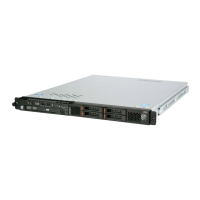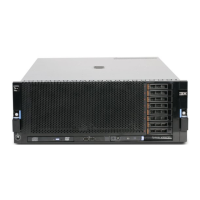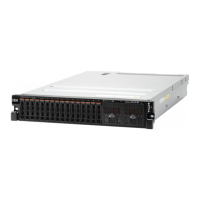• Checkpoint codes: Checkpoint codes track the progress of POST routines at system startup or reset.
Checkpoint codes are shown on the checkpoint code display, which is on the light path diagnostics panel.
Event logs
Error codes and messages are displayed in the following types of event logs. Some of the error codes and
messages in the logs are abbreviated.
When you are troubleshooting PCI-X slots, note that the event logs report the PCI-X buses numerically. The
numerical assignments vary depending on the configuration. You can check the assignments by running the
Setup utility (see
“Using the Setup utility” on page 517 for more information).
• POST event log: This log contains the three most recent error codes and messages that were generated
during POST. You can view the contents of the POST event log through the Setup utility.
• System-event log: This log contains messages that were generated during POST and all system status
messages from the service processor. You can view the contents of the system-event log from the Setup
utility. The system-event log is limited in size. When it is full, new entries will not overwrite existing entries;
therefore, you must periodically clear the system-event log through the Setup utility. When you are
troubleshooting an error, be sure to clear the system-event log so that you can find current errors more
easily.
Each system-event log entry is displayed on its own page. Messages are listed on the left side of the
screen, and details about the selected message are displayed on the right side of the screen. To move
from one entry to the next, use the Up Arrow (↑) and Down Arrow (↓) keys.
The system-event log indicates an assertion event when an event has occurred. It indicates a deassertion
event when the event is no longer occurring.
• Integrated management module (IMM) event log: This log contains a filtered subset of all IMM, POST,
and system management interrupt (SMI) events. You can view the IMM event log through the IMM web
interface and through the Dynamic System Analysis (DSA) program (as the ASM event log).
• DSA log: This log is generated by the Dynamic System Analysis (DSA) program, and it is a chronologically
ordered merge of the system-event log (as the IPMI event log), the IMM chassis-event log (as the ASM
event log), and the operating-system event logs. You can view the DSA log through the DSA program.
Viewing event logs from the Setup utility
Use this information to view event logs through the Setup utility.
To view the error logs, complete the following steps:
Step 1. Turn on the server.
Step 2. When the prompt <F1> Setup is displayed, press F1. If you have set both a power-on password and
an administrator password, you must type the administrator password to view the error logs.
Step 3. Select System Event Logs and use one of the following procedures:
• To view the POST event log, select POST Event Viewers.
• To view the IMM system-event log, select System Event Log.
Viewing event logs without restarting the server
If the server is not hung, methods are available for you to view one or more event logs without having to
restart the server.
If you have installed Dynamic System Analysis (DSA) Portable, you can use it to view the system-event log
(as the IPMI event log), the IMM event log (as the ASM event log), the operating-system event logs, or the
26
System x3550 M3Problem Determination and Service Guide

